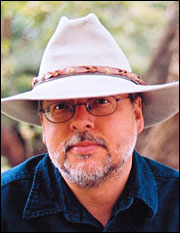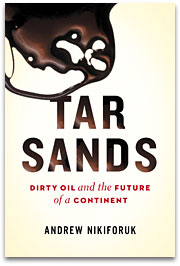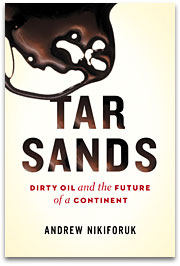Of all the absurdities at play in extracting oil from Alberta’s vast northern tar sands deposits, the most staggering might be the nuclear renaissance it threatens to create in Canada.
 Andrew NikiforukWhether nuclear energy presents a legitimate alternative to greenhouse-gas-emitting energy sources is one question. Environmentalists have long debated that. But Canada is considering something else entirely — building nuclear reactors not to free itself from fossil fuels but to literally dig itself deeper into their shrinking underground reserves.
Andrew NikiforukWhether nuclear energy presents a legitimate alternative to greenhouse-gas-emitting energy sources is one question. Environmentalists have long debated that. But Canada is considering something else entirely — building nuclear reactors not to free itself from fossil fuels but to literally dig itself deeper into their shrinking underground reserves.
Because processing bitumen into oil is such an energy-intensive process, Alberta and neighboring Saskatchewan have considered building new reactors to power the process. “If realized, these latest atomic visions for the tar sands would make Canada the only developed country in the world to employ nuclear power to accelerate the exploitation of carbon-rich fossil fuels,” Calgary journalist Andrew Nikiforuk writes in Tar Sands: Dirty Oil and the Future of a Continent.
The book, released in the U.S. on Monday, contains a damning account of the energy development in Alberta, where even the proper name for the black muck that oozes from the ground is in dispute. Critics like Nikiforuk call it tar. Advocates call it oil, its eventual processed form. Nikiforuk responds, “If that lazy reasoning made sense, Canadians would call every tomato ketchup and every tree lumber.” Bitumen, a heavy oil, is probably the most neutral term.
By any name, oil companies have invested some $150 billion (or $200 billion Canadian) in retrieving and processing it, making Canada the largest exporter of oil into the United States, ahead of even Saudi Arabia. Nikiforuk argues the development is both an environmental disaster and a threat to Canada’s health as a democracy.
“It’s not economical and it makes no environmental sense, and it only provides security to oil companies running out of oil,” Nikiforuk said last week. “It makes a lot of sense to Shell, because a third of its remaining oil reserves are in bitumen in Alberta. And the same thing applies to Exxon Mobil. In other words, these companies have no future unless they’re producing oil from the tar sands.”
 The publisher of Tar Sands, Greystone Books, believes in the book’s social importance enough to offer it as a free PDF download through Friday [Update: No longer available] (also check out Nikiforuk’s shorter “Declaration of a Political Emergency“).
The publisher of Tar Sands, Greystone Books, believes in the book’s social importance enough to offer it as a free PDF download through Friday [Update: No longer available] (also check out Nikiforuk’s shorter “Declaration of a Political Emergency“).
The book coincides with another hard-hitting look at the tar sands in the March issue of National Geographic. The magazine devotes 24 pages to the topic, including some stunning photos. Two of them show swaths of boreal forest (one of the planet’s crucial carbon sinks) before and after bulldozing. Another shows toxic tailings ponds sitting beside the Athabasca River, separated by a single levy from the world’s third-largest watershed (after the Amazon and the Mississippi). Still another shows a fake falcon perched above a pond, meant to scare off migrating birds like the 500 ducks that died last spring when they landed on the sludge.
Nat Geo’s Robert Kunzig describes the bitumen extraction process:
Nowhere on Earth is more earth being moved these days than in the Athabasca Valley. To extract each barrel of oil from a surface mine, the industry must first cut down the forest, then remove an average of two tons of peat and dirt that lie above the oil sands layer, then two tons of the sand itself. It must heat several barrels of water to strip the bitumen from the sand and upgrade it, and afterward it discharges contaminated water into tailings ponds like the one near Mildred Lake. They now cover around 50 square miles.
Adds Nikiforuk, “As a result, every barrel of bitumen produced from the tar sands creates, on average, three times more carbon dioxide emissions (187 pounds) than a barrel of normal crude (62 pounds).”
Since Tar Sands‘ Canadian release last fall, Nikiforuk said it has received a predictable round of denouncing from the Canadian government, which he accuses of having no comprehensive energy plan and of giving leasing tar-sands property for criminally low royalty rates.
On the other hand, responses from oil and gas companies have surprised him.
“Off the record, they’ll say that they actually agree with a great deal of what’s in the book,” he said. “What they’re really saying is that the resource has been poorly regulated. There’s little if any fiscal accountability to the wealth being generated by the tar sands, and the government has really mismanaged the pace and scale of development.”
The economic downturn and the collapse in oil prices have slowed development of the tar sands. Nikiforuk said he’s hopeful they will also inspire more sober political strategies.
“When oil was $150 a barrel, it was very hard to question the economics or environmental issues associated with the world’s largest energy project,” he said. “But now that oil is around $40 and a lot of the projects are clearly uneconomic, both Canadians and Americans have a real opportunity to reassess where they want to go with oil.”
When President Obama made his first international visit to Canada last month, enviros hoped he would give a clear indication that he understands the folly of tar sands development. He didn’t, suggesting instead that technology could be developed to clean up the process.
“What Americans haven’t realized yet is that the more locally they produce their own energy, the more money will circulate in local economies,” said Nikiforuk. “Less money spent on oil, whether it’s dirty Canadian oil or bloody Middle Eastern oil, means more money staying at home, enriching American communities … So the tar sands present a real opportunity for Americans to ask some hard questions about the future: bloody oil, dirty oil or renewables? By switching to dirty oil, you’re just putting things off.”
The tar sands have also caused social disruption in Alberta. Over the course of a decade, 340,000 people moved from Canada’s Atlantic provinces to Alberta to work in the development, 14 percent of the maritime provinces’ population. Nikiforuk describes the Deadwood-like Fort McMurray, the boomtown at the center of the development. But the population explosion has also wrought stark changes in Calgary, his hometown 460 miles to the south.
“The moral carelessness that accompanied that growth was evident in everyday life, everywhere,” he said of Calgary. “The traffic accidents, the shortage of doctors, the escalating gang violence related to supplying drugs to mining communities at Fort McMurray. Just the greed alone was palpable, and that affected me. That affected my family. And that’s why I wrote the book.”


